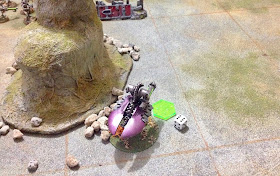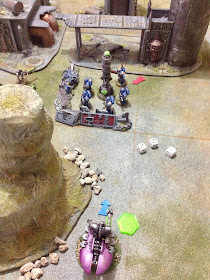 |
| A test game in progress using a 6 inch grid |
The rules are starting to come together into a style of game I want and enjoy. For me the activation approach used for units has been lacking in previous rulesets I have used, written or adapted. I have played a few games now with the new approach where the rules had lots of minor modifications noted down, then scribbled out, or just reworked and tweaked.
So here is the approach I am taking for the activation mechanism. It uses an IGO-UGO approach with players activating each of their units during their turn. To activate a unit a player rolls between 1-3 D6 depending on the type of unit and their situation:
- Low quality units (Robots) roll 1D6, but can roll 2D6 if they are adjacent to a leader.
- Medium quality (Veteran) units roll 2D6
- High quality (Elite) units, units with a hero, or units with a leader roll 3D6
Any odd scoring D6 allows a unit to make a move. Where two odd scores are rolled a unit may move twice. All movement must end if a unit enters a terrain feature, unless they are a type of unit that ignores terrain, such as a hoverer or flyer.
 |
| A unit of Necrons (low quality unit) roll 2 dice instead of 1 because they are next to a unit with a leader. A roll of 5 and 3 (odds) allows them to move twice as indicated by the red arrows. |
An even score allows a unit to shoot, assault, unpin or go into overwatch. Once a unit performs one of these activities it cannot perform any more actions during the players turn. A unit with two even scores can still only shoot or assault once, but can use both even scores to give them an advantage when shooting or assaulting an enemy unit. (Note - an assault occurs when a unit is adjacent to a target enemy unit and so can use close combat weapons. Both shooting and assaulting use the same combat mechanism for simplicity, except an assaulting unit moves into any squares vacated when an enemy unit is destroyed.)
 |
| 1) A unit with a leader rolls 3, 2, 4. It uses its odd score (3) to move forward as shown by the red arrow. |
When it is not a player's turn they can interrupt and activate a unit or units which are in overwatch to shoot or assault an enemy unit: about to be activated, is performing actions, or has finished activating.
 |
| During its turn a Necron Destroyer uses an even score to move into overwatch. |
 |
| Space Marine unit moves forward ready to assault, but the Destroyer uses its overwatch to shoot at the moved unit after it has moved and before it assaults. |
In between test games, where I pondered rule options, I was able to complete a unit of Dragoons for my 19th Century image-nations project. Next up is a couple of artillery units using various spare wheels and barrels to fix up this broken bits of brittle plastic.
 |
| A unit of Dragoons |

Hi Peter,
ReplyDeleteThis is a really neat mechanic. If you get three odd results, does this still mean a maximum of only two moves?
I'm looking to do a hex grid version of Black Ops and this looks like a perfect activation solution.
Cheers
Jay
Hi Jay,
DeleteI allow up to 3 moves as this is limited to leaders, heroes, and elite troops. Also, when moving into terrain movement must cease, so the likelihood of a unit moving three squares is reduced, but still possible.
With a Black Ops style game one approach could be for two odd (move) scores being used for a single cautious movement and overwatch units cannot react.
Good luck working through with your Black Ops hex based version.
Regards, Peter
The activation system will also be very helpful in solitaire play.
ReplyDeleteYes, it does bring a level of uncertainty which is helpful when playing.
DeleteQuite right, Norm!
DeleteThis comment has been removed by the author.
ReplyDeleteI like your newly recruited dragoons.
ReplyDeleteYour activation and action mechanism is an interest twist to DR based activations. While a unit may always do SOMETHING, that SOMETHING may not always be what is optimal or desired. From a command perspective that makes sense. Even a nearby leader cannot guarantee what operation a unit will undertake. Nifty idea and requires further consideration for me.
Thank you - The 19th Century project is coming along nicely. I am finding the straight forward figures of Spencer-Smith a refreshing change to paint.
DeleteI think the activation approach fits quite nicely for a SciFi game with squads as it gives them a change to do something, even if it is to retire.
Will this activation system be making its way to your rules page, please?
ReplyDeleteYes, I will post the rules. Probably in a few weeks time, just getting the combat mechanisms bedded down.
DeleteThank you.
ReplyDeleteLooks very interesting